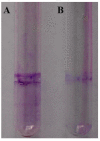Antibacterial Activity and Mechanism of Action of Sulfone Derivatives Containing 1,3,4-Oxadiazole Moieties on Rice Bacterial Leaf Blight
- PMID: 26114927
- PMCID: PMC6332022
- DOI: 10.3390/molecules200711660
Antibacterial Activity and Mechanism of Action of Sulfone Derivatives Containing 1,3,4-Oxadiazole Moieties on Rice Bacterial Leaf Blight
Abstract
In this study, sulfone derivatives containing 1,3,4-oxadiazole moieties indicated good antibacterial activities against rice bacterial leaf blight caused by the pathogen Xanthomonas oryzaepv. pv. oryzae (Xoo). In particular, 2-(methylsulfonyl)-5-(4-fluorobenzyl)-1,3,4-oxadiazole revealed the best antibacterial activity against Xoo, with a half-maximal effective concentration (EC50) of 9.89 μg/mL, which was better than those of the commercial agents of bismerthiazole (92.61 μg/mL) and thiodiazole copper (121.82 μg/mL). In vivo antibacterial activity tests under greenhouse conditions and field trials demonstrated that 2-(methylsulfonyl)-5-(4-fluorophenyl)-1,3,4-oxadiazole was effective in reducing rice bacterial leaf blight. Meanwhile, 2-(methylsulfonyl)-5-(4-fluorophenyl)-1,3,4-oxadiazole stimulate the increase in superoxide dismutase (SOD) and peroxidase (POD) activities in rice, causing marked enhancement of plant resistance against rice bacterial leaf blight. It could also improve the chlorophyll content and restrain the increase in the malondialdehyde (MDA) content in rice to considerably reduce the amount of damage caused by Xoo. Moreover, 2-(methylsulfonyl)-5-(4-fluorophenyl)-1,3,4-oxadiazole, at a concentration of 20 μg/mL, could inhibit the production of extracellular polysaccharide (EPS) with an inhibition ratio of 94.52%, and reduce the gene expression levels of gumB, gumG, gumM, and xanA, with inhibition ratios of 94.88%, 68.14%, 86.76%, and 79.21%, respectively.
Keywords: Xanthomonas oryzae pv. oryzae; action mechanism; antibacterial activity; extracellular polysaccharide; sulfone derivative.
Conflict of interest statement
The authors declare no conflict of interest.
Figures







References
-
- Mew T.W. Current status and future prospects of research on bacterial blight of rice. Annu. Rev. Phytopathol. 1987;25:359–382. doi: 10.1146/annurev.py.25.090187.002043. - DOI
-
- Nayak D., Shanti M.L., Bose L.K., Singh U.D., Nayak P. Pathogenicity association in Xanthomonas oryzae pv. oryzae the causal organism of rice bacterial blight disease. ARPN J. Agric. Biol. Sci. 2008;3:12–26.
-
- Shanti M.L., Devi G.L., Kumar G.N., Shashidhar H.E. Molecular marker-assisted selection: A tool for insulating parental lines of hybrid rice against bacterial leaf blight. Int. J. Plant Pathol. 2010;1:114–123. doi: 10.3923/ijpp.2010.114.123. - DOI
-
- Evidente A., Venturi V., Masi M., Degrassi G., Cimmino A., Maddau L., Andolfi A. In vitro antibacterial activity of sphaeropsidins and chemical derivatives toward Xanthomonas oryzae pv. oryzae, the causal agent of rice bacterial blight. J. Nat. Prod. 2011;74:2520–2525. doi: 10.1021/np200625m. - DOI - PubMed
-
- Khoshkdaman M., Ebadi A.A., Kahrizi D. Evaluation of pathogencity and race classification of Xanthomonas oryzae pv. oryzae in guilan province-Iran. Agric. Sci. 2012;3:557–561.
Publication types
MeSH terms
Substances
LinkOut - more resources
Full Text Sources
Other Literature Sources
Medical

